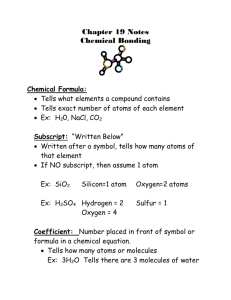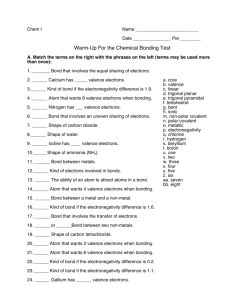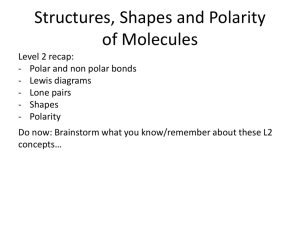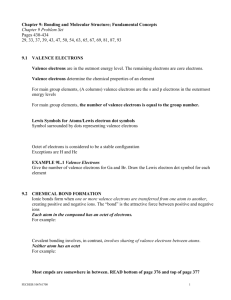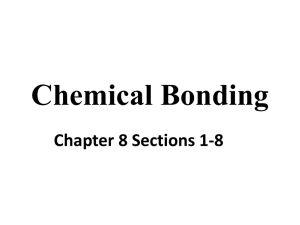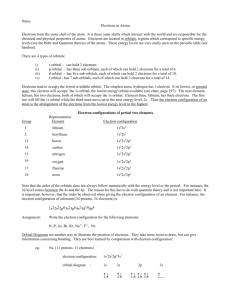Chemical Bonding - Chapter 12 Study Guide To answer these
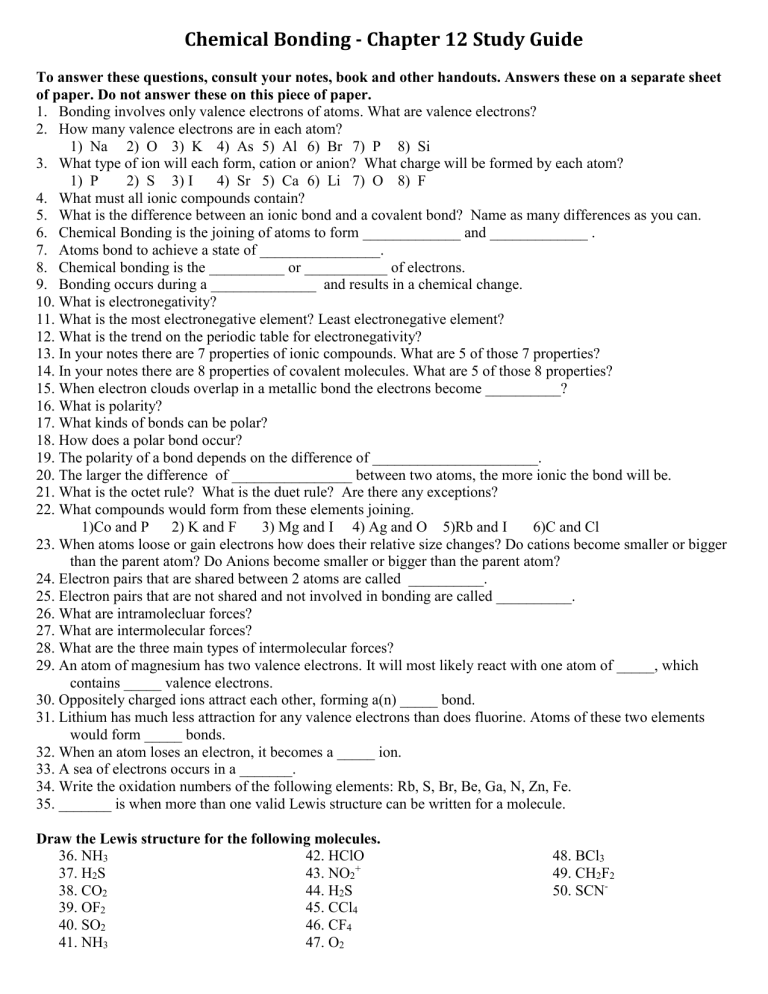
Chemical Bonding - Chapter 12 Study Guide
To answer these questions, consult your notes, book and other handouts. Answers these on a separate sheet of paper. Do not answer these on this piece of paper.
1.
Bonding involves only valence electrons of atoms. What are valence electrons?
2.
How many valence electrons are in each atom?
1) Na 2) O 3) K 4) As 5) Al 6) Br 7) P 8) Si
3.
What type of ion will each form, cation or anion? What charge will be formed by each atom?
1) P 2) S 3) I 4) Sr 5) Ca 6) Li 7) O 8) F
4.
What must all ionic compounds contain?
5.
What is the difference between an ionic bond and a covalent bond? Name as many differences as you can.
6.
Chemical Bonding is the joining of atoms to form _____________ and _____________ .
7.
Atoms bond to achieve a state of ________________.
8.
Chemical bonding is the __________ or ___________ of electrons.
9.
Bonding occurs during a ______________ and results in a chemical change.
10.
What is electronegativity?
11.
What is the most electronegative element? Least electronegative element?
12.
What is the trend on the periodic table for electronegativity?
13.
In your notes there are 7 properties of ionic compounds. What are 5 of those 7 properties?
14.
In your notes there are 8 properties of covalent molecules. What are 5 of those 8 properties?
15.
When electron clouds overlap in a metallic bond the electrons become __________?
16.
What is polarity?
17.
What kinds of bonds can be polar?
18.
How does a polar bond occur?
19.
The polarity of a bond depends on the difference of ______________________.
20.
The larger the difference of ________________ between two atoms, the more ionic the bond will be.
21.
What is the octet rule? What is the duet rule? Are there any exceptions?
22.
What compounds would form from these elements joining.
1)Co and P 2) K and F 3) Mg and I 4) Ag and O 5)Rb and I 6)C and Cl
23.
When atoms loose or gain electrons how does their relative size changes? Do cations become smaller or bigger than the parent atom? Do Anions become smaller or bigger than the parent atom?
24.
Electron pairs that are shared between 2 atoms are called __________.
25.
Electron pairs that are not shared and not involved in bonding are called __________.
26.
What are intramolecluar forces?
27.
What are intermolecular forces?
28.
What are the three main types of intermolecular forces?
29.
An atom of magnesium has two valence electrons. It will most likely react with one atom of _____, which contains _____ valence electrons.
30.
Oppositely charged ions attract each other, forming a(n) _____ bond.
31.
Lithium has much less attraction for any valence electrons than does fluorine. Atoms of these two elements would form _____ bonds.
32.
When an atom loses an electron, it becomes a _____ ion.
33.
A sea of electrons occurs in a _______.
34.
Write the oxidation numbers of the following elements: Rb, S, Br, Be, Ga, N, Zn, Fe.
35.
_______ is when more than one valid Lewis structure can be written for a molecule.
Draw the Lewis structure for the following molecules.
36.
NH
3
37.
H
2
S
42.
HClO
43.
NO
2
+
38.
CO
2
39.
OF
2
40.
SO
2
41.
NH
3
44.
H
2
S
45.
CCl
4
46.
CF
4
47.
O
2
48.
49.
BCl
CH
2
3
F
50.
SCN -
2




